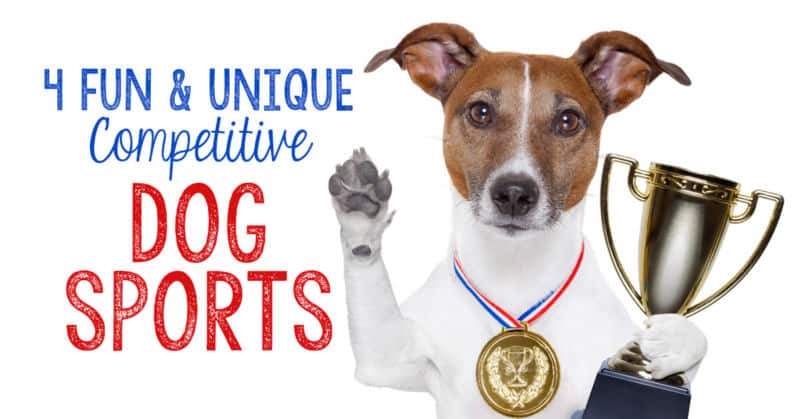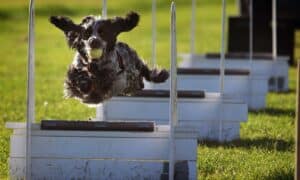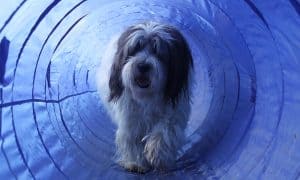“This post contains affiliate links, and I will be compensated if you make a purchase after clicking on my links.”
As devoted pet parents, we’re always looking for fun new ways to both exercise our dogs’ bodies and minds and to enrich their lives. While competitive dog sports have been around just about as long as humans began sharing their hearts and homes with dogs, new and exciting dog sports are springing up year after year.

Some dog sports harness your dog’s natural abilities, including their amazing sense of smell, a hard-wired prey drive, or exceptional athletics, while others rely on newly trained skills and working together as a team.
Some sports are great for dog-friendly dogs, while others provide an outlet for those fearful or reactive dogs that might otherwise not be suitable for canine competitions. No matter your dog’s unique personality, skills and abilities, there’s a dog sport that’s perfect just for him!
Check out these four fun and unique competitive sports that are taking the dog world by storm:
Nosework
Nosework, also known as scent work, is a relatively new competitive dog sport modeled after the amazing work performed by professional scent detection dogs. Using the same methods employed to train drug and explosive detection dogs, search and rescue dogs, and other professional working dogs, any dog, of any breed, age, or physical ability – as long as they can smell – can join in the fun.
While there are several organizations that host Nosework competitions, each with their own set of rules and regulations, the basics are the same across the board. Dogs are trained to use their most powerful tool, their nose, to sniff out certain novel odors that are hidden from view.
Most organizations train dogs to detect three specific odors; birch, anise, and clove. Odors are hidden in each of four different locations, interiors (inside a building), exteriors (outside), vehicles (somewhere on the outside of a parked vehicle), and in containers (boxes, suitcases, bags, etc.). In competitions, a dog will be given a set amount of time, usually 2 to 5 minutes, to enter the search area and find the hide or hides. It is up to the handler to recognize their dog’s body language, be able to distinguish when their dog has located an odor, and call “alert” when the dog has reached the source of the odor. The bond that’s developed between a Nosework dog and their handler is just one of many things that attracts dog owners to the sport.
Because Nosework is performed only one dog and handler team at a time, because earning titles and awards are typically awarded on a pass or fail basis rather than a competition to be the fastest, and because odor searches don’t generally require more than basic physical activity, just about any dog can participate including senior dogs, dogs with disabilities, blind or deaf dogs, and fearful or reactive dogs that might otherwise be limited from dog sports. And, because dogs are performing a skill they’re naturally good at, it’s an excellent confidence builder!
Flyball
Although Flyball actually got its start in the 1970’s, it’s only recently begun to explode in popularity to become a more widely enjoyed dog sport. Flyball is essentially a relay race for ball-loving dogs. It’s fast-paced, exciting, and an excellent form of exercise for the dogs participating.
In a Flyball competition, two teams of four dogs race side-by-side over a 51’ long course. One at a time, the dogs must run down the length of the course, jumping over hurdles until they reach the end where they retrieve a ball from a Flyball box and return to the start line to release the next dog on their team. The race ends when all four dogs on a team have completed the course successfully in the fastest time.
While all dog breeds can compete in Flyball, it does require great speed and agility, jumping over hurdles, and retrieving, so competing dogs will need to be physically fit and high energy. Additionally, because the sport is a multi-dog relay race, reactive dogs, or those that don’t play well with others, may not be suitable to participate.
Treibball
Treibball (pronounced try-ball) began several years ago in Germany but recently spread across the globe to become one of the fastest growing new dog sports in America. Treibbal, which translates to “push ball” is a low-impact, easy to train, and fun to play sport in which a dog “herds” a number of large inflatable exercise balls from a field and into a net.
To play, eight large balls are arranged into a triangle in the center of a large field, slightly smaller than a football field, with a goal or pen, similar to a soccer goal, at one end. Competitors have 15 minutes to “herd” all eight balls into the net, using only their nose or shoulders to push the ball toward the goal. The dog’s handler may not touch the balls still in play and can only direct their dog using calm commands, either verbal or using hand signals. The dog and handler team who successfully herds all eight balls in the fastest time wins the game.
Of course, herding breeds tend to take to the sport more quickly due to their natural herding instincts, but energetic, prey-driven, and fun-loving dogs can enjoy the sport as well. And, because it is performed one dog/handler team at a time, many reactive dogs have had great success with Treibball, too.
Treibball promotes teamwork, communication, and an exceptional bond between dog and handler. The biggest hurdle dog owners will face when getting started in Treibball is the requirement that their dogs work well and respond to cues while off-leash.
Barn Hunt
Barn Hunt is an exciting competitive dog sport that’s as much fun for the handler to watch as it is for the dog to play! The sport takes place either inside a barn or outside in a fenced-in area where a maze course has been built using hay bales that are stacked to create tunnels and obstacles over which the dog must navigate to find a rat hidden in the hay.
Perfect for prey-driven dogs or those that love to search and hunt, dogs that can fit through an 18” opening between two bales of hay can compete in the sport. Because the sport requires some climbing and tunneling, dogs should be both comfortable and physically able to do both. In Barn Hunt competitions, a rat, or multiple rats, depending on the dog’s skill level, is hidden somewhere within the maze of hay bales. The location of the hide is unknown to both the dog and handler. Dogs are given a specific length of time to locate the rat, at which time the handler must signal that it’s been found. Dogs are scored on their speed, agility, and their ability to navigate the course effectively.
The live rats used in Barn Hunt are contained inside a PVC tube designed to safely and humanely protect the rat. They are filled with comfortable bedding and have room to turn around. At no point in a game of Barn Hunt is the rat at risk of being injured or killed and great care is taken to ensure their safety. In addition, rats used have all been conditioned for the sport and are comfortable and stress-free in their tubes.
The sport of Barn Hunt requires a strong bond and excellent communication between a dog and his handler. And, because the sport is performed one dog/handler team at a time, mildly reactive dogs can often participate.
Remember, you don’t have to join a league or pay for expensive memberships to participate in dog sports. It’s easy to build your own backyard courses or play fun scent detection and tracking games at home. And, there are dozens of other dog sports not named above that may be the perfect fit for your unique dog! (Look into Dock Diving, Herding, Agility, Weightpull, Earthdog Trials, Rally Obedience, Surfing, Canine Freestyle, Disc Dog, High Jump, and many more!) Just remember to keep it fun and always make it a rewarding experience for your pup.
Do you participate in any dog sports? Tell us about your experiences and how the sport has improved your dog’s life in a comment below!
























Great article!
I really didn’t know about treibball and flyball, they look very cool. Maybe we’ll try them out.
Know all the four competitive dog sports here in Brandy Arnold’s article – dogingtonpost.com.